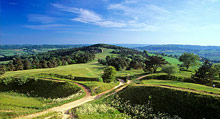Before There Were Luxury Cottages in the UK: The History of the Cotswolds

Picture it. You’re living in the area known as the “heart of England”. Around you there are green hills, stone walls, small villages, and just a sense of distinct natural beauty. You’ve heard of the history of the luxury cottages in the UK at the old Bruern abbey where you are staying, but what about the rest of the region?
In this article, we’ll take a look at the history of the Cotswolds, before it became a destination for luxury self-catering cottages in the UK, and see what life was like back before the tourist scene.
The Wool Industry
The region of the Cotswolds most likely got its name from two Middle English words: “Cot” (sheep enclosure) and “Wold” (hill). Early on, the Cotswolds was known for its sheep population-and, in turn, the quality of wool that was produced here. Many of the towns in the Cotswolds survived-or thrived-during the Middle Ages because of the wool trade. Wool was so valuable it was protected by royal mandates and required to be used for burials. This was so that there was less trading of this prime English commodity and more use of it by English citizens themselves.
While wool is no longer a primary export of the Cotswolds, there are still historic houses and parts of towns you can visit that were part of the wool-making industry. There are also many streets or villages named for where the sheep were held, herded, or sheared. In fact, Bruern’s own luxury holiday rental, Shipton, shares one of those similar names.
The English Civil War
The Cotswolds were right at the center of the English Civil War(s), for both sides. Between 1642-1645 and 1648-1649, King Charles I and the Parliament at the time were at odds over a number of issues, including the divine rights of the monarchy, taxes, and religion (King Charles I had married a Catholic queen and England was not a Catholic country).
Many battles took place in the Cotswolds, as Oxford became the headquarters for the forces of King Charles I, and a number of towns became stalwarts for Parliamentary supporters. Despite the number of battles fought in the Cotswold villages, to go there today, you’d be hard-pressed to believe that two bloody wars occurred there. While you may hear tales of the battlegrounds being haunted at night by the former soldiers, most of the villages have retained or restored their picturesque nature and only the stories have stayed alive.
Industries
Because of the lush lands in the Cotswolds, and its convenient location for many passers-through, different villages in the Cotswolds thrived in different industries. Many inns were opened for passing coaches; silk production increased under the rule of King James I (and therefore so did glove-making), and tobacco production was also common in certain towns. The tobacco planting led to many fights and eventually led to a ban on all planting of tobacco, but to this today, occasionally, the rare tobacco plant is found in Winchcombe.
Breweries have also been a large part of industry in the Cotswolds,
The Arts and Crafts Movement (1860-1910) also played a large role in the history of the Cotswolds. The artists of the Cotswolds worked to combine traditional craftsmanship with medieval decoration. The Hart Gold and Silversmiths, based in Chipping Camden, is England’s last connection to this influential era of English artistry. There are also a number of houses open for tours in the Cotswolds that were designed with this prelude to Art Nouveau in mind.
An Area of Outstanding Natural Beauty

When you stay at Bruern’s luxury cottages in the UK, it’s hard not to notice the beauty of the scenery around you. In fact, it’s quite difficult to escape, and conservationists have agreed that these picturesque sites need to be preserved.
In 1966, the Cotswolds were designated an Area of Outstanding National Beauty by Natural England. This means that these grounds were “designated for conservation due to their significant landscape value.” They are currently maintained by the Cotswolds Conservation Board, and are open for all to explore.
Explore While Relaxing at a Luxury Cottage in the UK
Today, much of the Cotswolds’ industry is supported by tourists, whether they come for the history, the arts, the natural beauty, or a stay at a luxury cottage in the UK. Regardless of the reason, the Cotswolds remains an attractive place for all visitors, for a day, a weekend, or an extended holiday.

